标签:creating oca struct pre service frame rom sub mmu
设计模式主要分为三种类型:
These design patterns are all about class instantiation or object creation. These patterns can be further categorized into Class-creational patterns and object-creational patterns. While class-creation patterns use inheritance effectively in the instantiation process, object-creation patterns use delegation effectively to get the job done.
Creational design patterns are the Factory Method, Abstract Factory, Builder, Singleton, Object Pool, and Prototype.
These design patterns are about organizing different classes and objects to form larger structures and provide new functionality.
Structural design patterns are Adapter, Bridge, Composite, Decorator, Facade, Flyweight, Private Class Data, and Proxy.
Behavioral patterns are about identifying common communication patterns between objects and realize these patterns.
Behavioral patterns are Chain of responsibility, Command, Interpreter, Iterator, Mediator, Memento, Null Object, Observer, State, Strategy, Template method, Visitor
Singleton pattern is a design pattern which restricts a class to instantiate its multiple objects. It is nothing but a way of defining a class. Class is defined in such a way that only one instance of the class is created in the complete execution of a program or project. Singleton classes are used for logging, driver objects, caching and thread pool, database connections.
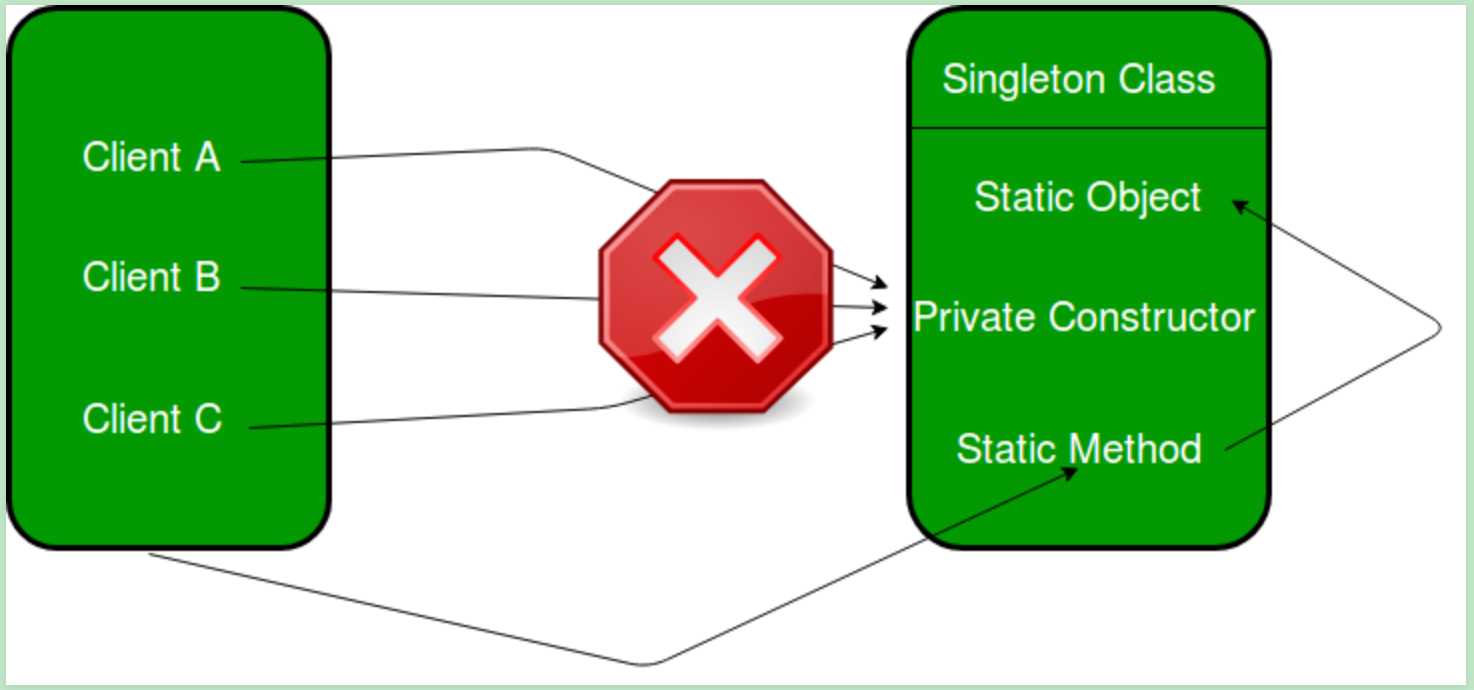
An implementation of singleton class should have following properties:
Singleton class can be instantiated by two methods:
Early initialization : In this method, class is initialized whether it is to be used or not. The main advantage of this method is its simplicity. You initiate the class at the time of class loading. Its drawback is that class is always initialized whether it is being used or not.
In Factory pattern, we create object without exposing the creation logic to client and the client use the same common interface to create new type of object.
The idea is to use a static member-function (static factory method) which creates & returns instances, hiding the details of class modules from user.
A factory pattern is one of the core design principles to create an object, allowing clients to create objects of a library(explained below) in a way such that it doesn’t have tight coupling with the class hierarchy of the library.
https://www.geeksforgeeks.org/abstract-factory-pattern/
Abstract Factory pattern is almost similar to Factory Pattern is considered as another layer of abstraction over factory pattern. Abstract Factory patterns work around a super-factory which creates other factories.
Abstract factory pattern implementation provides us a framework that allows us to create objects that follow a general pattern. So at runtime, abstract factory is coupled with any desired concrete factory which can create objects of desired type.
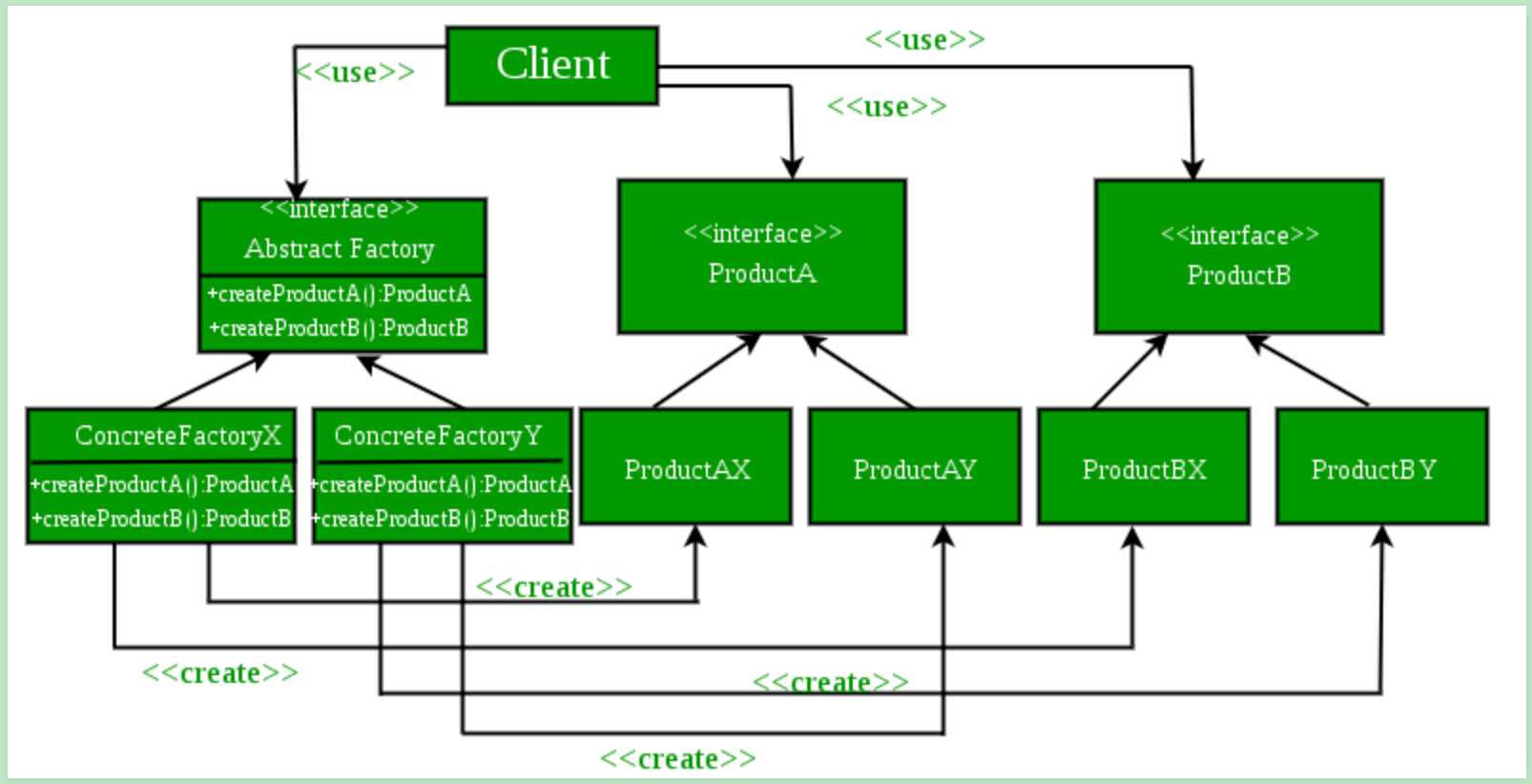
UML class diagram example for the Abstract Factory Design Pattern.
Abstract Factory provides interfaces for creating families of related or dependent objects without specifying their concrete classes.
Client software creates a concrete implementation of the abstract factory and then uses the generic interfaces to create the concrete objects that are part of the family of objects.
The client does not know or care which concrete objects it gets from each of these concrete factories since it uses only the generic interfaces of their products.
So with this idea of Abstract Factory pattern, we will now try to create a design that will facilitate the creation of related objects.
https://www.geeksforgeeks.org/prototype-design-pattern/
Prototype allows us to hide the complexity of making new instances from the client. The concept is to copy an existing object rather than creating a new instance from scratch, something that may include costly operations. The existing object acts as a prototype and contains the state of the object. The newly copied object may change same properties only if required. This approach saves costly resources and time, especially when the object creation is a heavy process.
The prototype pattern is a creational design pattern. Prototype patterns is required, when object creation is time consuming, and costly operation, so we create object with existing object itself. One of the best available way to create object from existing objects are clone() method. Clone is the simplest approach to implement prototype pattern. However, it is your call to decide how to copy existing object based on your business model.
Prototype Design Participants
1) Prototype : This is the prototype of actual object.
2) Prototype registry : This is used as registry service to have all prototypes accessible using simple string parameters.
3) Client : Client will be responsible for using registry service to access prototype instances.
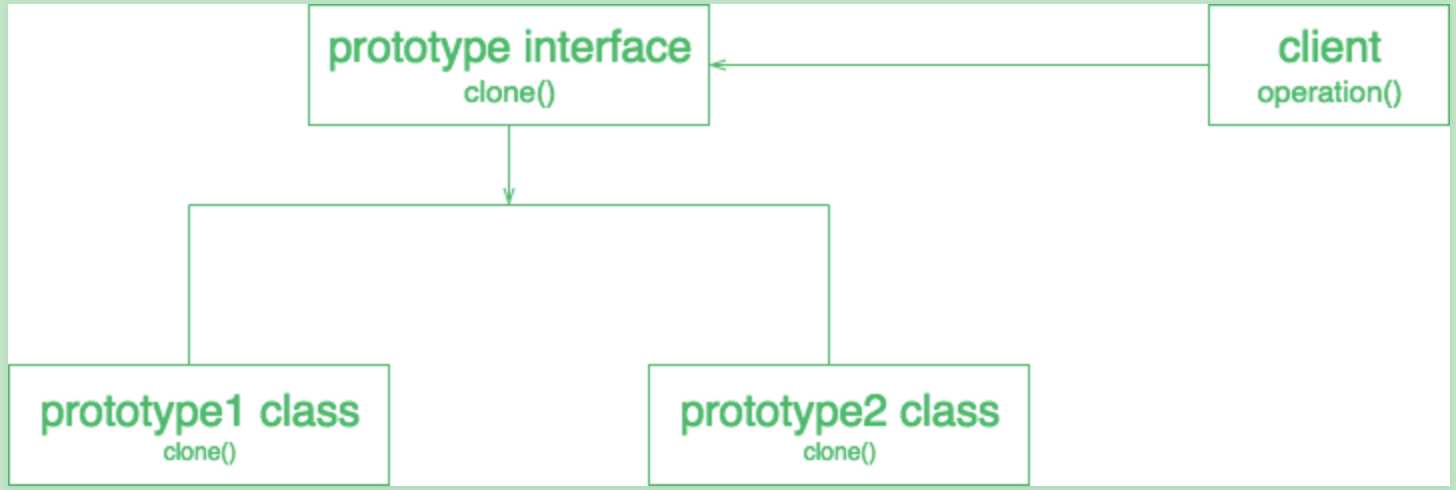
https://www.geeksforgeeks.org/bridge-design-pattern/
https://www.geeksforgeeks.org/composite-design-pattern/
https://www.geeksforgeeks.org/the-decorator-pattern-set-2-introduction-and-design/
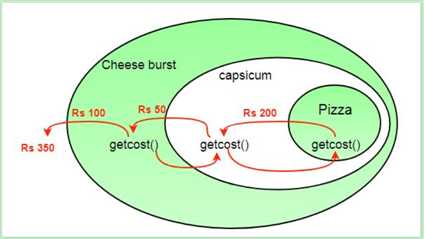
What we get in the end is a pizza with cheeseburst and capsicum toppings. Visualize the “decorator” objects like wrappers. Here are some of the properties of decorators:
Definition:
The decorator pattern attaches additional responsibilities to an object dynamically. Decorators provide a flexible alternative to subclassing for extending functionality.
Class Diagram:

mage src: Wikipedia
Advantages:
Disadvantages:
https://www.geeksforgeeks.org/facade-design-pattern-introduction/
As the name suggests, it means the face of the building. The people walking past the road can only see this glass face of the building. They do not know anything about it, the wiring, the pipes and other complexities. It hides all the complexities of the building and displays a friendly face.
In Java, the interface JDBC can be called a facade because, we as users or clients create connection using the “java.sql.Connection” interface, the implementation of which we are not concerned about. The implementation is left to the vendor of driver.
Another good example can be the startup of a computer. When a computer starts up, it involves the work of cpu, memory, hard drive, etc. To make it easy to use for users, we can add a facade which wrap the complexity of the task, and provide one simple interface instead. It hides the complexities of the system and provides an interface to the client from where the client can access the system.
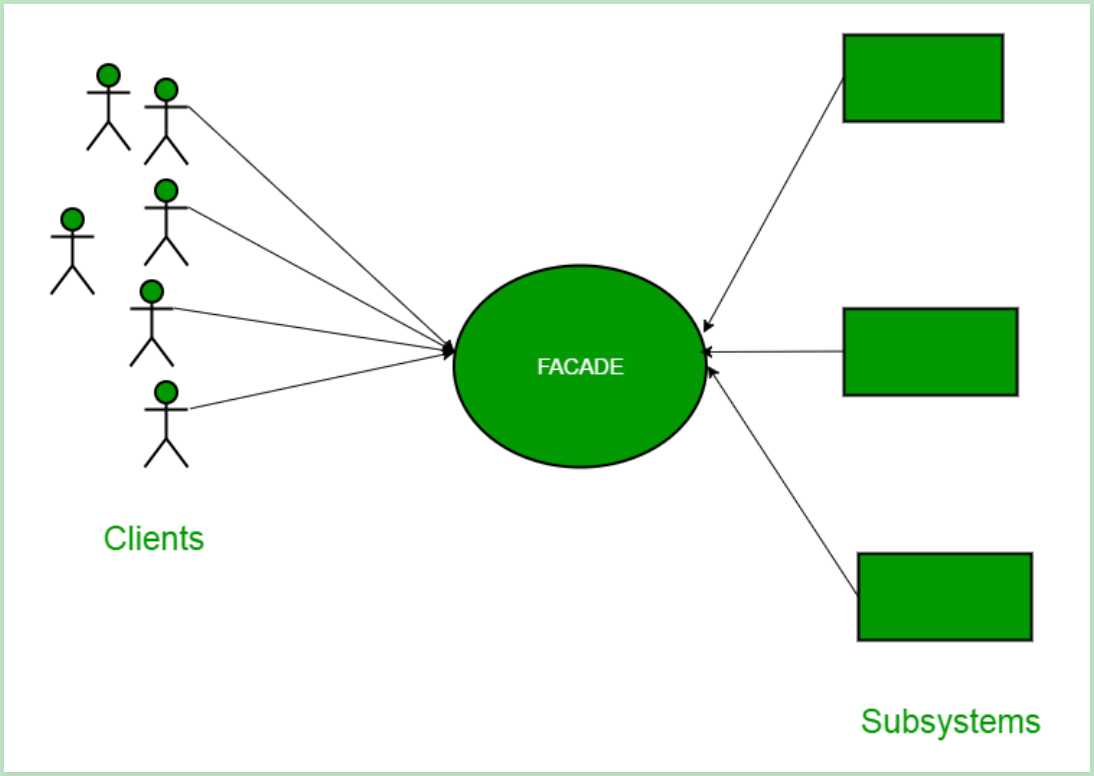
When Should this pattern be used?
The facade pattern is appropriate when you have a complex system that you want to expose to clients in a simplified way, or you want to make an external communication layer over an existing system which is incompatible with the system. Facade deals with interfaces, not implementation. Its purpose is to hide internal complexity behind a single interface that appears simple on the outside.
https://www.geeksforgeeks.org/flyweight-design-pattern/
Flyweight pattern is used when we need to create a large number of similar objects (say 105). One important feature of flyweight objects is that they are immutable. This means that they cannot be modified once they have been constructed.
In Flyweight pattern we use a HashMap that stores reference to the object which have already been created, every object is associated with a key. Now when a client wants to create an object, he simply has to pass a key associated with it and if the object has already been created we simply get the reference to that object else it creates a new object and then returns it reference to the client.
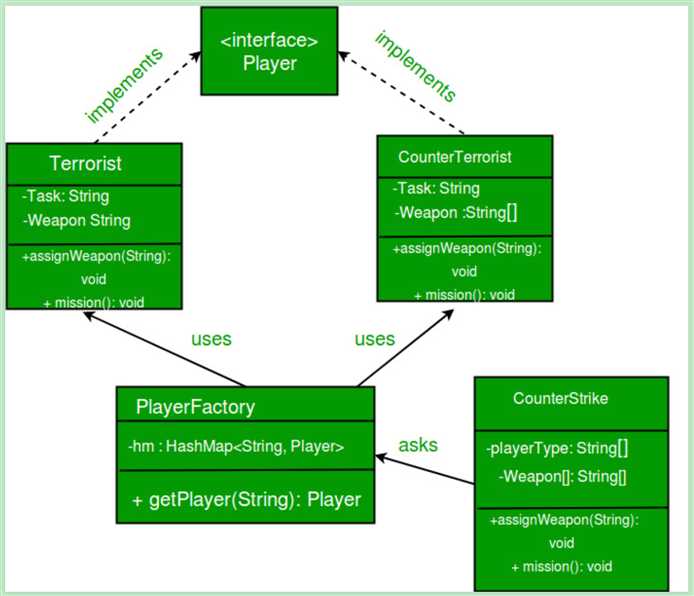
https://www.geeksforgeeks.org/proxy-design-pattern/
Proxies are also called surrogates, handles, and wrappers. They are closely related in structure, but not purpose, to Adapters and Decorators.
Proxy pattern “Controls and manage access to the object they are protecting“.
As in the decorator pattern, proxies can be chained together. The client, and each proxy, believes it is delegating messages to the real server:
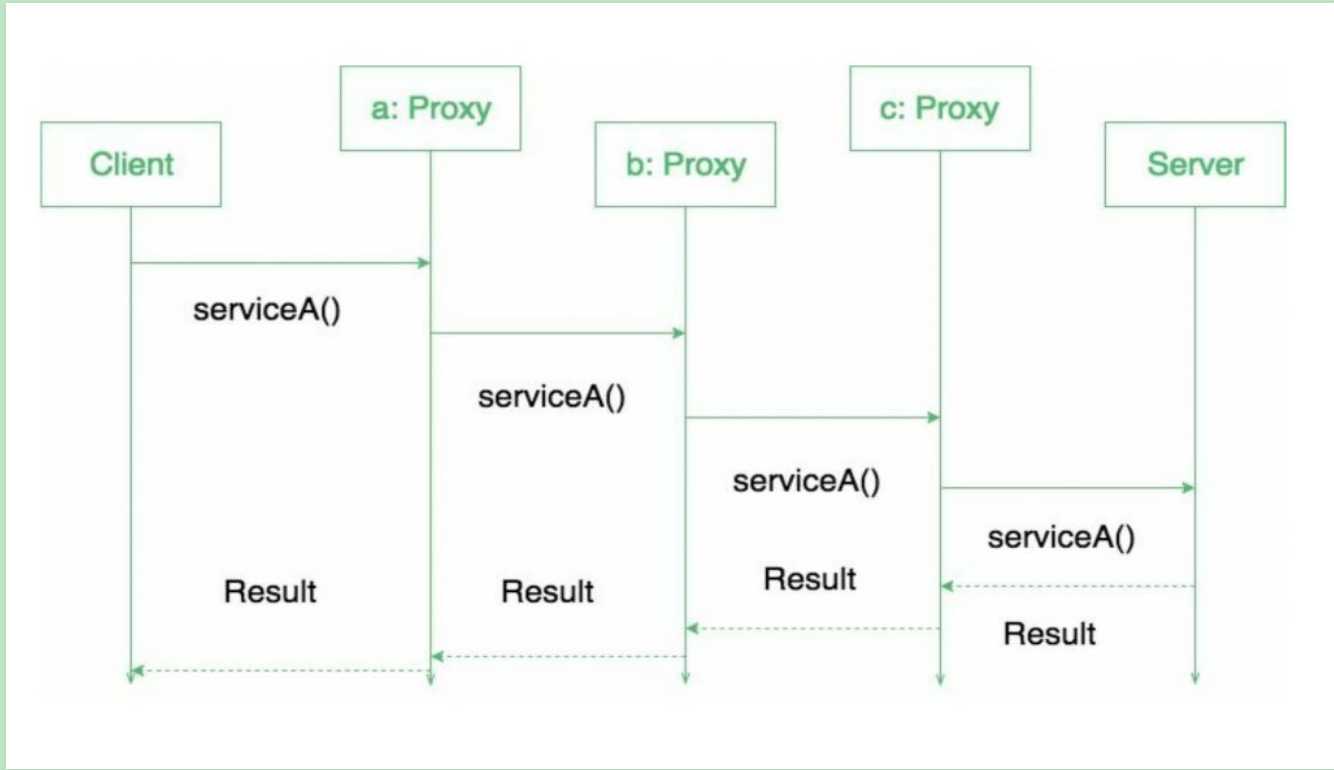
Types of proxies
Remote proxy:
They are responsible for representing the object located remotely. Talking to the real object might involve marshalling and unmarshalling of data and talking to the remote object. All that logic is encapsulated in these proxies and the client application need not worry about them.
Virtual proxy:
These proxies will provide some default and instant results if the real object is supposed to take some time to produce results. These proxies initiate the operation on real objects and provide a default result to the application. Once the real object is done, these proxies push the actual data to the client where it has provided dummy data earlier.
Protection proxy:
If an application does not have access to some resource then such proxies will talk to the objects in applications that have access to that resource and then get the result back.
Smart Proxy:
A smart proxy provides additional layer of security by interposing specific actions when the object is accessed. An example can be to check if the real object is locked before it is accessed to ensure that no other object can change it.
Benefits:
Drawbacks/Consequences:
This pattern introduces another layer of abstraction which sometimes may be an issue if the RealSubject code is accessed by some of the clients directly and some of them might access the Proxy classes. This might cause disparate behaviour.
Interesting points:
https://www.geeksforgeeks.org/observer-pattern-set-1-introduction/
https://www.geeksforgeeks.org/observer-pattern-set-2-implementation/
Definition:
The Observer Pattern defines a one to many dependency between objects so that one object changes state, all of its dependents are notified and updated automatically.
Explanation:
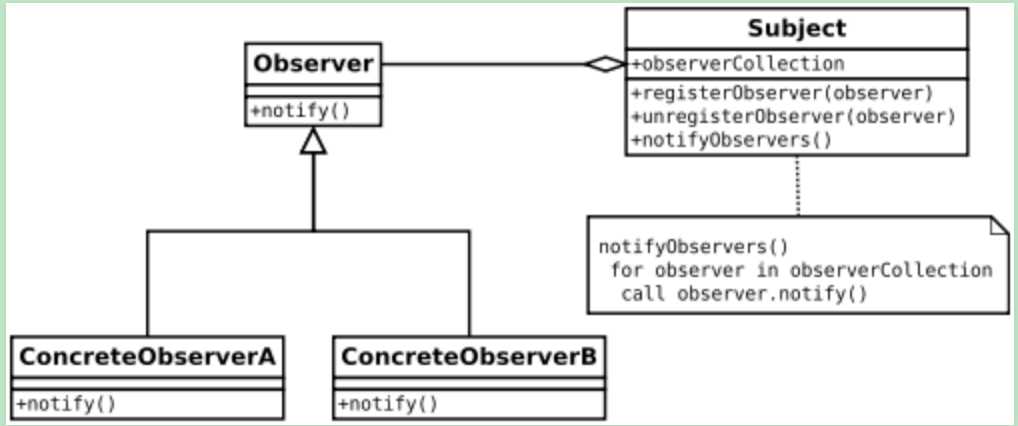
Suppose we are building a cricket app that notifies viewers about the information such as current score, run rate etc. Suppose we have made two display elements CurrentScoreDisplay and AverageScoreDisplay. CricketData has all the data (runs, bowls etc.) and whenever data changes the display elements are notified with new data and they display the latest data accordingly
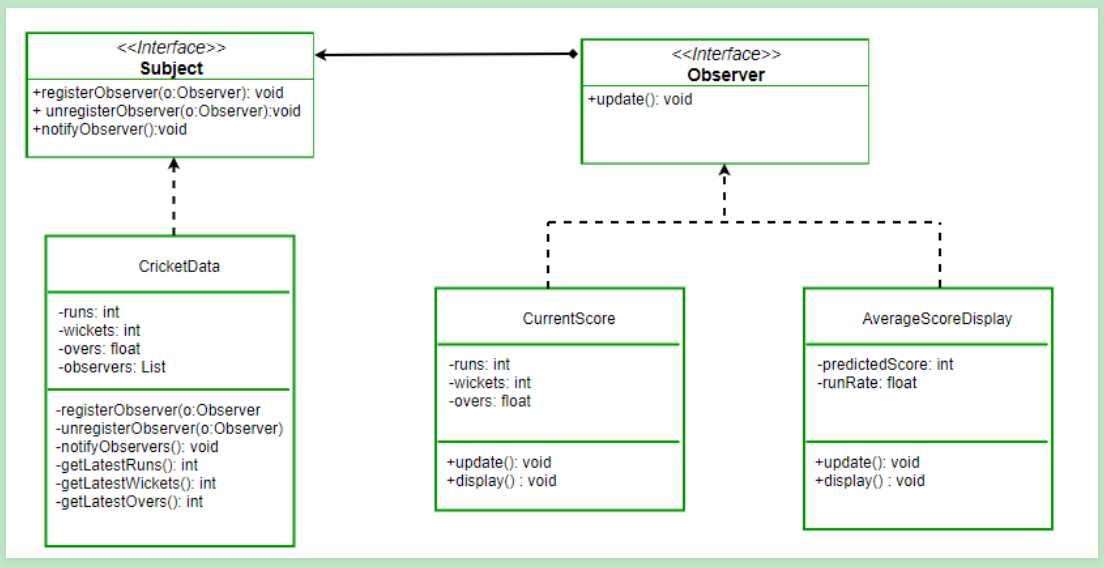
Definition:
Wikipedia defines strategy pattern as:
“In computer programming, the strategy pattern (also known as the policy pattern) is a software design pattern that enables an algorithm’s behavior to be selected at runtime. The strategy pattern
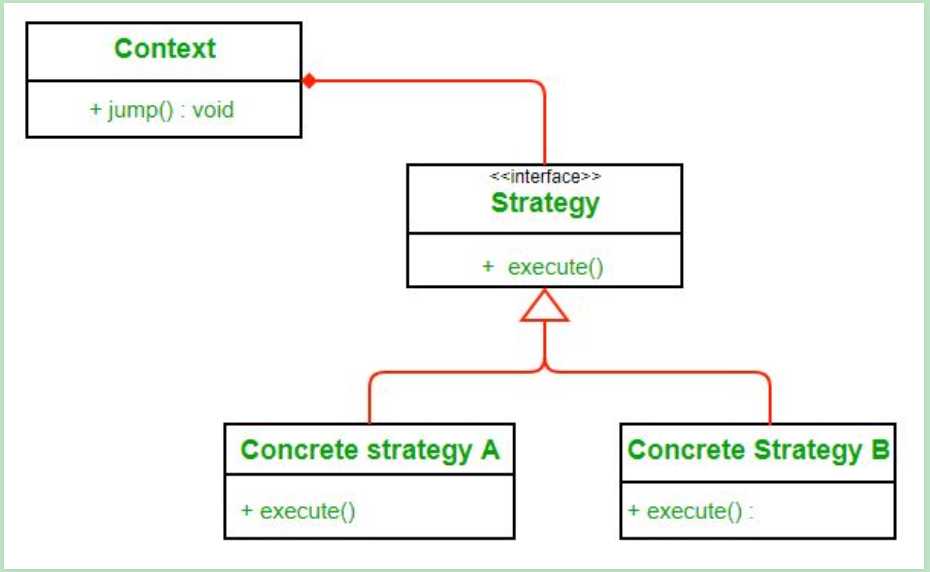
Here we rely on composition instead of inheritance for reuse. Context is composed of a Strategy. Instead of implementing a behavior the Context delegates it to Strategy. The context would be the class that would require changing behaviors. We can change behavior dynamically. Strategy is implemented as interface so that we can change behavior without affecting our context.
We will have a clearer understanding of strategy pattern when we will use it to solve our problem.
Advantages:
Disadvantages:
4.12 Template method(TODO)
4.13 Visitor(TODO)
Refernces:
https://www.geeksforgeeks.org/design-patterns-set-1-introduction/
https://www.geeksforgeeks.org/design-patterns-set-2-factory-method/
标签:creating oca struct pre service frame rom sub mmu
原文地址:https://www.cnblogs.com/elaron/p/11968245.html